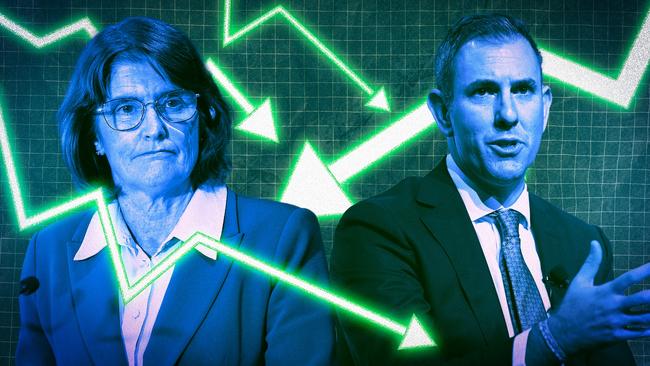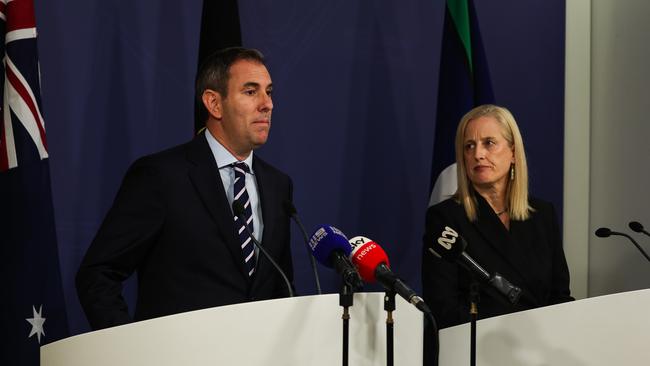Jim Chalmers jawbones RBA for double rate cut amid fears of Trump-induced global recession
Most economists have ruled out any emergency intra-meeting rate cut, saying the central bank should remain cautious about just how deflationary the US tariffs will be for Australia.

Jim Chalmers has talked up a half-percentage-point interest rate cut at the Reserve Bank’s meeting next month, saying he and bank governor Michele Bullock were working out how to prepare for economic uncertainty after almost $100bn was wiped off the local stockmarket in a day.
Financial markets priced in a 33 per cent chance of a half-percentage-point cut in May, and fully locked in a quarter-point cut, but most economists ruled out any emergency intra-meeting rate cut, saying the central bank should remain cautious about just how deflationary the US tariffs will be for Australia.
“There’s more than 50 per cent expectation in the markets that the next Reserve Bank interest rate cut in May might be as big as 50 basis points,” Dr Chalmers said, “But I don’t predict or pre-empt those decisions.
“I also spoke this morning, before the market opened, with governor Michele Bullock to compare notes. We’re obviously seeing these very substantial falls in the sharemarket but also comparing notes when it comes to the impact on the real economy.
“Both of us, her in her independent way and the government, are working out how to ensure that we can best calibrate for this economic uncertainty.”
Treasury released its third version of modelling of the tariffs, showing barely any change to inflation over the next four years, with inflation to increase by 0.2 percentage points in 2025 relative to a baseline scenario with no tariffs, before dipping in 2026 and 2027. Economic growth was dampened by only about 0.1 of a percentage point.
Economist Warwick McKibbin, who designed the modelling used by Treasury, said he did not see a recession for Australia under any scenario, although his modelling excluded the impact of investor confidence.
RBC chief economist Su-Lin Ong said while a half-percentage-point rate cut can’t be ruled out in May, it was unlikely to happen, and that a quarter percentage point was now the most probable, leaving the cash rate at 3.85 per cent.
“History suggests that the RBA sticks to (quarter-percentage-point) moves unless circumstances and shocks are substantial with transmission through to the real economy.”

Jarden chief economist Micaela Fuchila expected the RBA to “wait and see” the inflation and jobs data, both due later this month, before it rushed to cut interest rates.
“Fundamentally, the economy is not really screaming that we need cuts,” Ms Fuchila said, tipping the central bank would stand pat at its next meeting and wait until July to deliver a quarter-percentage-point rate cut.
Also supporting the case for the RBA to keep the cash rate on hold at 4.1 per cent was the recent drop in the Australian dollar, which on Monday was struggling to stay above US60c, having plunged to a five-year low of US59.33 early in trading.
Warning that the local currency “could even get weaker”, Ms Fuchila said the dollar’s depreciation threatened to push up imported prices, keeping the RBA on the sidelines.
While the Australian dollar has fallen to the five-year low of around $US0.60, it fell 39 per cent in the global financial crisis and 19 per cent in the pandemic, yet the RBA still cut rates.
But AMP chief economist Shane Oliver said the central bank cut rates during those huge currency depreciations because the “threat to growth swamped any threat of higher inflation”.
“The same will likely apply in response to Trump’s tariff shock,” Dr Oliver said.

NSW Treasury Corporation chief economist Brian Redican said as the value of financial assets fell, commercial banks would need to hold more capital, which leads to the rationing of credit and a reduction in business investment.
“I don’t think there is any benefit in cutting before the May meeting. If it did it might only exacerbate fears of what is already happening,” he said.
Alex Joiner, chief economist at asset management firm IFM Investors, said calls for a half-percentage-point rate cut were “overdone”.
“That would be the RBA panicking and I don’t think there’s justification for that just yet,” Dr Joiner said.
“We won’t be immune from a negative impact if there is a global slowdown, but I don’t think we’re at the epicentre of it.”
HSBC chief economist Paul Bloxham, however, was more bullish on rate cuts, warning a half-percentage-point cut at the RBA’s May meeting still remained a “risk”. But with the board’s next decision not due for another six weeks, the RBA would have much more certainty about the impact of the tariffs by then, he said. “A lot can happen in six weeks and at some point there is going to be a circuit-breaker.”





To join the conversation, please log in. Don't have an account? Register
Join the conversation, you are commenting as Logout